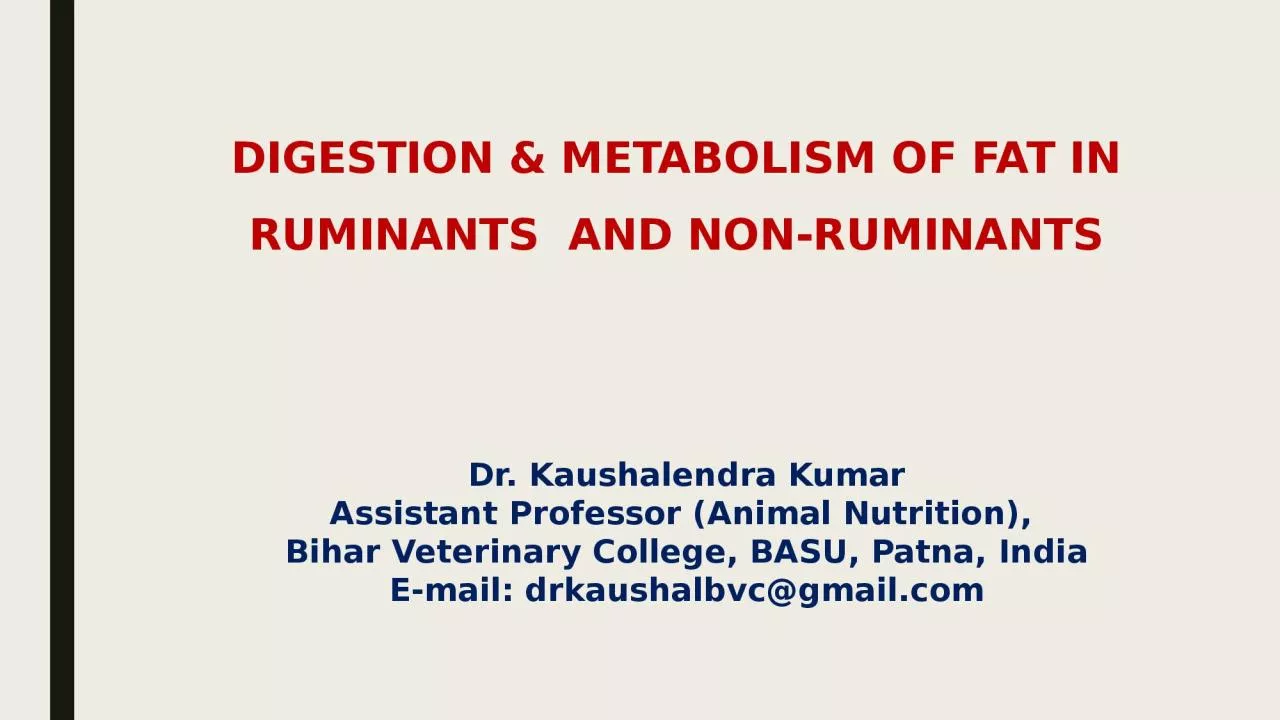

Assistant Professor Animal Nutrition Bihar Veterinary College BASU Patna India Email drkaushalbvcgmailcom DIGESTION amp METABOLISM OF FAT IN RUMINANTS AND NONRUMINANTS Digestion and absorption of fat in nonruminant and ruminant species ID: 930103
Download Presentation The PPT/PDF document "Dr. Kaushalendra Kumar" is the property of its rightful owner. Permission is granted to download and print the materials on this web site for personal, non-commercial use only, and to display it on your personal computer provided you do not modify the materials and that you retain all copyright notices contained in the materials. By downloading content from our website, you accept the terms of this agreement.
Slide1
Dr. Kaushalendra KumarAssistant Professor (Animal Nutrition), Bihar Veterinary College, BASU, Patna, IndiaE-mail: drkaushalbvc@gmail.com
DIGESTION & METABOLISM OF FAT IN
RUMINANTS AND NON-RUMINANTS
Slide2Digestion and absorption of fat in non-ruminant and ruminant species
Digestion before the small intestine
Substantial lipolysis can happen in the stomach of suckling animals, both non-ruminants and ruminants.
Main site of secretion of lipase seems to be in the lingual and pharyngeal regions.
In adult ruminants, microbial fermentation and lipids undergo hydrolysis, followed by hydrogenation
Major difference between ruminant (form of free fatty acid) & non-ruminant (esterified) digestion of lipid appears at the beginning of SI.
Slide3Digestion in the small intestine of monogastric animalsDietary triglycerides entering the SI from stomach, mixed with discharges of bile & pancreatic juice in the duodenum.Lipase and colipase
hydrolyse
TG droplet into FA & monoglycerides.
In absence of colipase or bile
, lipase get absorbed and denatured at the interface.Bile salt but no colipase, lipase remains in the aqueous phase & colipase is required for the attachment of lipase at the substrate-water interface Micelle formation, permit cholesterol & fat-soluble vitamins to be solubilized in the hydrophobic core, and then get absorbed.
Cont......
Slide4Digestion in the small intestine of ruminantsDietary lipid reaching the SI of ruminant is the FFA fractions, bounded as an insoluble complex with the feed particles.Transfer of fatty acid from the insoluble, particulate phase to the soluble, micellar phase.
Cont......
Slide5Common enzymes involve in fat digestion
Name of enzymes
Systematic name
Source
Substrate
Enzymes acting on ester links
Triacylglycerol lipase (Lipase)
Triacylglycerol acylhydrolase
Pancreas
TriacylglycerolsCholesterol esterase Sterol-ester hydrolasePancreas and small intestine Cholesterol estersPhospholipase A2 (Lecithinase A)Phosphatide 2-acyl-hydrolasePancreas and small intestine Lecithin and cephalinLysophospholipase (Lysolecithinase)Lysolecithin acyl-hydrolaseSmall intestine LysolecithinDeoxyribonuclease (DNase)Dexoyribonucleate 5’-oligonucleotido-hydrolasePancreas and small intestine DNARibonuclease 1 (RNase) Ribonucleate 3’-pyrimidino-oligonucleotido-hydrolasePancreas and small intestine RNANucleosidase N-Ribosyl-purine ribohydrolaseSmall intestine NucleosidesPhosphatases Small intestine Orthophosphoric acid esters
Cont......
Slide6Absorption of fat in non-ruminant and ruminant speciesAbsorption of fat occurs in jejunum of SI & micelle formation is crucial for efficient fatty acid absorption in all species.
In case of non-ruminant species, monoacylglycerols are required for micelle creation,
However, nearly complete hydrolysis of dietary FA in the rumen are absent from digesta present in the SI of the ruminants.
Bile provides, bile salts and lecithin, whereas, pancreatic juice delivers enzymes to convert lecithin to lysolecithins & bicarbonate to elevate
pH. Cont......
Slide7Digestion and absorption of lipids in non-ruminant animalsCont......
Slide8Digestion and absorption of lipids in ruminant animalsCont......
Slide9Factors affecting digestion and absorption of fatsShort and medium chained fatty acid are utilized better in comparison with long chain fatty acid. Unsaturated fatty acids are well utilized than saturated fatty acids.
Degree of esterification of fatty acid i.e. triglyceride > diglyceride > monoglyceride.
• Ratio of unsaturated and saturated fatty acids.
Cont......
Slide10Metabolism of fat in different species of animalsAfter absorption, either enter oxidative pathways for energy production, or transported to the adipose tissues & incorporated into the body fats.
The complete oxidation of fat yields about
2.25 times
more energy than carbohydrates.
Slide11Oxidation of FA to Acetyl CoA & β-Oxidation of palmitic acid
Cont......
Slide12Overview of fat metabolismCont......
Slide13Net yield of energy on oxidation of tripalmitin and starch
1. Tripalmitin (806 g/mole)
C
51
H98O6 (+3 H2O) + 72.5 O2
= 51 CO
2
+ 52 H
2
O + 7657 Kcal Glycerol 19 ATPPalmitate Phosphorylation-2 ATP 7 cleavages x 5 ATP+35 ATP 8 acetyl CoA x 12 ATP+96 ATP Net (129 ATP x 3)387 ATPTotal yield406 ATPCont......
Slide142. Starch (162 g/mole, glucose basis)
C
6
H
10O5 (+H2O) + 6O2 = 6 CO2 + 6 H2
O +
680 Kcal
Glycolysis
10 ATP Phosphorylation-2 ATP NADH – mitochondria-2 ATPNet yield6 ATPOxidation of 2 pyruvate 6 ATP2 acetyl CoA x 12 24 ATPTotal yield36 ATPCont......
Slide153. Based on gross energy
a)
7657 Kcal ÷ 806 g = 9.5 Kcal/g of fat
b)
680 Kcal ÷ 162 g = 4.20 Kcal/g of carbohydrate
Net yield
9.5 Kcal ÷ 4.20 Kcal = 2.26
4. Based on ATP production
a)406 ATP ÷ 806 g = 0.504 ATP/g of fatb)36 ATP ÷ 162 g = 0.222 ATP/g of carbohydrateNet yield0.504 ATP ÷ 0.222 ATP = 2.27Cont......
Slide16Synthesis of fatty acidSynthesis of fat (glycerides) occurs in the body from fatty acyl CoA & L-glycerol-3-phosphate, take place in most tissues, but is confined mostly to the liver & adipose tissue.Three systems of fatty acid synthesis;
In the cell cytoplasm, mainly in the production of palmitate from acetyl CoA or butyryl-CoA,
Another occurs chiefly in ER & minor extent in mitochondria, elongation of FA chains by 2-C addition with malonyl CoA as donor,
Finally they confined to the ER which carries about desaturation of preformed fatty acids.
Cont......
Slide17Cytosolic synthesis of palmitate
Desaturation of preformed fatty acids
Synthesis of triacylglycerols
Elongation of fatty acid chain
Cont......
Slide18Fat metabolism in ruminantsHydrolysisBiohydrogenation
Cont......
Slide19THANKSDiscussion..........Questions, if any?